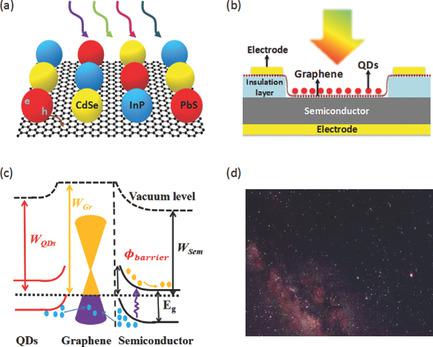当前位置:
X-MOL 学术
›
Adv. Funct. Mater.
›
论文详情
Our official English website, www.x-mol.net, welcomes your feedback! (Note: you will need to create a separate account there.)
The Interaction between Quantum Dots and Graphene: The Applications in Graphene‐Based Solar Cells and Photodetectors
Advanced Functional Materials ( IF 19.0 ) Pub Date : 2018-09-21 , DOI: 10.1002/adfm.201804712 Jianghong Wu 1 , Yanghua Lu 1 , Sirui Feng 1 , Zhiqian Wu 1 , Shuyuan Lin 1 , Zhenzhen Hao 1 , Tianyi Yao 1 , Xinming Li 2 , Hongwei Zhu 2 , Shisheng Lin 1, 3
Advanced Functional Materials ( IF 19.0 ) Pub Date : 2018-09-21 , DOI: 10.1002/adfm.201804712 Jianghong Wu 1 , Yanghua Lu 1 , Sirui Feng 1 , Zhiqian Wu 1 , Shuyuan Lin 1 , Zhenzhen Hao 1 , Tianyi Yao 1 , Xinming Li 2 , Hongwei Zhu 2 , Shisheng Lin 1, 3
Affiliation

|
Graphene with a series of neoteric electronic and optical properties is an intriguing building block for optoelectronic devices. Over the past decade, graphene‐based solar cells (SCs) and photodetectors (PDs) which can convert light signals to electrical signals have received burgeoning exploration. However, limited light absorption hampers the performance of these devices. Quantum dots (QDs) possess a strong confinement effect, a large exciton energy, and long exciton lifetime, enhancing the interaction between incident light and graphene. Especially, as the density of states near the Dirac point of graphene is ultralow, it is easy to modify the Fermi level of graphene by inserting quantum dots at the interface between graphene and light, thereby enhancing the performance of graphene‐based optoelectronic devices. The characteristics of QDs and crucial physical mechanisms of the interaction and energy transfer in QDs/graphene nanohybrids are systematically addressed. The factors influencing the efficiency of energy transfer are also analyzed quantitatively. Moreover, the experimental process of QD‐enhanced technologies for SCs, photoconductors, phototransistors, and photodiode PDs is reviewed. Eventually, a conclusion is given and the remaining challenges and future development for QDs/2D materials hybrid systems is discussed. Possible steps toward large‐scale commercial applications and integration into optoelectronic networks are suggested.
中文翻译:

量子点与石墨烯之间的相互作用:在基于石墨烯的太阳能电池和光电探测器中的应用
具有一系列现代电子和光学特性的石墨烯是光电子器件的一个引人入胜的组成部分。在过去的十年中,可以将光信号转换为电信号的基于石墨烯的太阳能电池(SC)和光电探测器(PD)受到了蓬勃发展的探索。但是,有限的光吸收会影响这些设备的性能。量子点(QD)具有较强的约束作用,大的激子能量和长的激子寿命,从而增强了入射光与石墨烯之间的相互作用。尤其是,由于石墨烯Dirac点附近的状态密度极低,因此可以通过在石墨烯与光之间的界面插入量子点来修改石墨烯的费米能级,从而提高基于石墨烯的光电器件的性能。系统地研究了量子点的特性以及量子点/石墨烯纳米杂化物中相互作用和能量转移的关键物理机制。还对影响能量转移效率的因素进行了定量分析。此外,对用于SC,光电导体,光电晶体管和光电二极管PD的QD增强技术的实验过程进行了回顾。最后,给出了结论,并讨论了QDs / 2D材料混合系统的剩余挑战和未来发展。建议采取大规模商业应用并集成到光电网络的可能步骤。此外,对用于SC,光电导体,光电晶体管和光电二极管PD的QD增强技术的实验过程进行了回顾。最后,给出了结论,并讨论了QDs / 2D材料混合系统的剩余挑战和未来发展。建议采取可能的步骤,将其应用于大规模的商业应用并集成到光电网络中。此外,对用于SC,光电导体,光电晶体管和光电二极管PD的QD增强技术的实验过程进行了回顾。最后,给出了结论,并讨论了QDs / 2D材料混合系统的剩余挑战和未来发展。建议采取可能的步骤,将其应用于大规模的商业应用并集成到光电网络中。
更新日期:2018-09-21
中文翻译:

量子点与石墨烯之间的相互作用:在基于石墨烯的太阳能电池和光电探测器中的应用
具有一系列现代电子和光学特性的石墨烯是光电子器件的一个引人入胜的组成部分。在过去的十年中,可以将光信号转换为电信号的基于石墨烯的太阳能电池(SC)和光电探测器(PD)受到了蓬勃发展的探索。但是,有限的光吸收会影响这些设备的性能。量子点(QD)具有较强的约束作用,大的激子能量和长的激子寿命,从而增强了入射光与石墨烯之间的相互作用。尤其是,由于石墨烯Dirac点附近的状态密度极低,因此可以通过在石墨烯与光之间的界面插入量子点来修改石墨烯的费米能级,从而提高基于石墨烯的光电器件的性能。系统地研究了量子点的特性以及量子点/石墨烯纳米杂化物中相互作用和能量转移的关键物理机制。还对影响能量转移效率的因素进行了定量分析。此外,对用于SC,光电导体,光电晶体管和光电二极管PD的QD增强技术的实验过程进行了回顾。最后,给出了结论,并讨论了QDs / 2D材料混合系统的剩余挑战和未来发展。建议采取大规模商业应用并集成到光电网络的可能步骤。此外,对用于SC,光电导体,光电晶体管和光电二极管PD的QD增强技术的实验过程进行了回顾。最后,给出了结论,并讨论了QDs / 2D材料混合系统的剩余挑战和未来发展。建议采取可能的步骤,将其应用于大规模的商业应用并集成到光电网络中。此外,对用于SC,光电导体,光电晶体管和光电二极管PD的QD增强技术的实验过程进行了回顾。最后,给出了结论,并讨论了QDs / 2D材料混合系统的剩余挑战和未来发展。建议采取可能的步骤,将其应用于大规模的商业应用并集成到光电网络中。


























 京公网安备 11010802027423号
京公网安备 11010802027423号